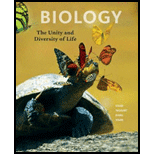
Organic molecules consist mainly of ______ atoms.
- a. carbon
- b. carbon and oxygen
- c. carbon and hydrogen
- d. carbon and nitrogen
Introduction: The molecules that are majorly composed of carbon and hydrogen are classified by chemists as organic molecules. The basis of life is the organic compounds that make it up. Organic chemistry is the study of these compounds. The methodology of synthesis of these compounds is called as organic synthesis.
Answer to Problem 1SQ
Correct answer: The organic compounds are those that consist majorly of carbon and hydrogen atoms. Hence, the correct answer is option c.
Explanation of Solution
Reason for correct answer:
The living organisms are composed of several molecules. They are called as molecules of life. The molecules of life include carbohydrates, fats, proteins, nucleic acids, and many more. They are made of organic molecules, which mainly consist majorly of carbon and hydrogen atoms. The organic molecules also have oxygen, nitrogen, sulphur, and phosphorus atoms in a minor form. These organic molecules are also found in the non-living things.
Option c. is given as “carbon and hydrogen”.
The organic compounds consist mainly of both carbon and hydrogen atoms that are present in different proportions to form various functional groups.
Hence the correct answer is option c.
Reason for incorrect answer:
Option a. is given as “carbon”.
Though the carbon atoms majorly constitute the organic compounds, chemists define organic compounds as those with both carbon and hydrogen atoms. Hence, option a. is incorrect.
Option b. is given as “carbon and oxygen”.
Certain organic molecules like carboxylic acids, carbonyl functions groups, aldehyde groups, and ketone groups contain both carbon and oxygen atoms; oxygen is present in lesser amount than hydrogen. Hence, option b. is incorrect.
Option d. is given as “carbon and nitrogen”.
Certain organic molecules like amino acids, nucleic acids, phospholipids, amides, amines, nitrile, and imine functional groups. Hence, option d. is incorrect.
Hence the options a., b., and d are incorrect.
Want to see more full solutions like this?
Chapter 3 Solutions
Biology: The Unity and Diversity of Life (MindTap Course List)
Additional Science Textbook Solutions
The Cosmic Perspective (8th Edition)
HUMAN ANATOMY
Campbell Essential Biology (7th Edition)
Genetics: From Genes to Genomes
Biology: Life on Earth with Physiology (11th Edition)
- Can you described the image? Can you explain the question as well their answer and how to get to an answer to an problem like this?arrow_forwardglg 112 mid unit assignment Identifying melting processesarrow_forwardGive only the mode of inheritance consistent with all three pedigrees and only two reasons that support this, nothing more, (it shouldn't take too long)arrow_forward
- Oarrow_forwardDescribe the principle of homeostasis.arrow_forwardExplain how the hormones of the glands listed below travel around the body to target organs and tissues : Pituitary gland Hypothalamus Thyroid Parathyroid Adrenal Pineal Pancreas(islets of langerhans) Gonads (testes and ovaries) Placentaarrow_forward
- What are the functions of the hormones produced in the glands listed below: Pituitary gland Hypothalamus Thyroid Parathyroid Adrenal Pineal Pancreas(islets of langerhans) Gonads (testes and ovaries) Placentaarrow_forwardDescribe the hormones produced in the glands listed below: Pituitary gland Hypothalamus Thyroid Parathyroid Adrenal Pineal Pancreas(islets of langerhans) Gonads (testes and ovaries) Placentaarrow_forwardPlease help me calculate drug dosage from the following information: Patient weight: 35 pounds, so 15.9 kilograms (got this by dividing 35 pounds by 2.2 kilograms) Drug dose: 0.05mg/kg Drug concentration: 2mg/mLarrow_forward
- A 25-year-old woman presents to the emergency department with a 2-day history of fever, chills, severe headache, and confusion. She recently returned from a trip to sub-Saharan Africa, where she did not take malaria prophylaxis. On examination, she is febrile (39.8°C/103.6°F) and hypotensive. Laboratory studies reveal hemoglobin of 8.0 g/dL, platelet count of 50,000/μL, and evidence of hemoglobinuria. A peripheral blood smear shows ring forms and banana-shaped gametocytes. Which of the following Plasmodium species is most likely responsible for her severe symptoms? A. Plasmodium vivax B. Plasmodium ovale C. Plasmodium malariae D. Plasmodium falciparumarrow_forwardStandard Concentration (caffeine) mg/L Absorbance Reading 10 0.322 20 0.697 40 1.535 60 2.520 80 3.100arrow_forwardPlease draw in the missing answer, thank youarrow_forward
 Concepts of BiologyBiologyISBN:9781938168116Author:Samantha Fowler, Rebecca Roush, James WisePublisher:OpenStax College
Concepts of BiologyBiologyISBN:9781938168116Author:Samantha Fowler, Rebecca Roush, James WisePublisher:OpenStax College
 Biology (MindTap Course List)BiologyISBN:9781337392938Author:Eldra Solomon, Charles Martin, Diana W. Martin, Linda R. BergPublisher:Cengage Learning
Biology (MindTap Course List)BiologyISBN:9781337392938Author:Eldra Solomon, Charles Martin, Diana W. Martin, Linda R. BergPublisher:Cengage Learning Human Biology (MindTap Course List)BiologyISBN:9781305112100Author:Cecie Starr, Beverly McMillanPublisher:Cengage Learning
Human Biology (MindTap Course List)BiologyISBN:9781305112100Author:Cecie Starr, Beverly McMillanPublisher:Cengage Learning Biology: The Unity and Diversity of Life (MindTap...BiologyISBN:9781337408332Author:Cecie Starr, Ralph Taggart, Christine Evers, Lisa StarrPublisher:Cengage Learning
Biology: The Unity and Diversity of Life (MindTap...BiologyISBN:9781337408332Author:Cecie Starr, Ralph Taggart, Christine Evers, Lisa StarrPublisher:Cengage Learning





